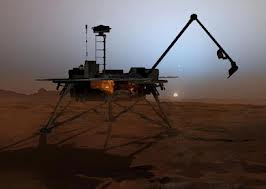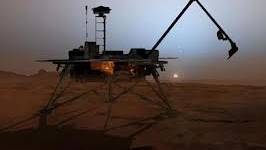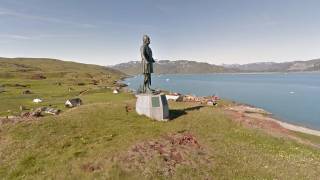Has Mars Preserved Evidence of Ancient Life? Groundbreaking New Look at the 1976 Viking Mission Findings
Source: dailygalaxy.com

Almost 40 years ago, two NASA probes on the surface of Mars scooped the soil in search of signs of microbes. The results that came back from the twin Viking missions were, to say the least, ambiguous. The scientific literature contains decades of debate over what they found. Rather than focusing on the question of life, a new SETI Institute-lead study, which was carried out at NASA Ames, was more interested in defining the martian environment that the Vikings sampled. The results suggest the landers not only found evidence of perchlorate salts on the surface, but there also should be highly reactive related compounds that can decompose organic compounds at low temperatures and explain the results of the Viking biology experiments.
Was that environment habitable, however? Richard Quinn, who is a SETI Institute researcher with Ames’ Planetary Systems Branch, says the more relevant question now is how well Mars can preserve evidence of ancient biosignatures, or chemical signs of life. This focus began to shift in 2009, he said, after published results showed NASA’s Mars Phoenix mission detected perchlorates at the north pole.
"People are always looking back at the Viking results. They were never thoroughly explained," Quinn said. "The Phoenix mission has focused the science debate in a new direction, and it’s moved away from superoxide-peroxide based chemistry to a chlorine and chlorine-oxide based chemistry."
The difference sounds subtle to the outsider, but looking closer, it does reveal a "different picture" about how habitable the soil is – which is something scientists are still investigating, Quinn added.
"Based on what we know about life in extreme environments, interpretations of mission results indicate that we are currently exploring habitable ancient environments on Mars, and I believe that these are solid interpretations. What the discovery of perchlorate tells us about is how the surface of Mars may have evolved in more recent times. The question is about preservation potential of biosignatures rather than the intrinsic habitability of the ancient environment."
NASA sent the twin Viking landers for a 1976 arrival on the Red Planet, which was an ambitious first for an agency that had just performed the first manned landing on the Moon nine years beforehand. Both missions performed flawlessly for many Earth years beyond their 90-day expiration date.
NASA’s Viking Mission was composed of two spacecraft, Viking 1 and Viking 2, each consisting of an orbiter and a lander. The primary mission objectives were to obtain high resolution images of the Martian surface, characterize the structure and composition of the atmosphere and surface, and search for evidence of life. Viking 1 was launched on August 20, 1975 and arrived at Mars on June 19, 1976.
The first month of orbit was devoted to imaging the surface to find appropriate landing sites for the Viking Landers. On July 20, 1976 the Viking 1 Lander separated from the Orbiter and touched down at Chryse Planitia. Viking 2 was launched September 9, 1975 and entered Mars orbit on August 7, 1976. The Viking 2 Lander touched down at Utopia Planitia on September 3, 1976.
The Orbiters imaged the entire surface of Mars at a resolution of 150 to 300 meters, and selected areas at 8 meters. The lowest periapsis altitude for both Orbiters was 300 km. The Viking 2 Orbiter was powered down on July 25, 1978 after 706 orbits, and the Viking 1 Orbiter on August 17, 1980, after over 1400 orbits.
The results from the Viking experiments gave what was then our most complete view of Mars. Volcanoes, lava plains, immense canyons, cratered areas, wind-formed features, and evidence of surface water are apparent in the Orbiter images. The planet appears to be divisible into two main regions, northern low plains and southern cratered highlands. Superimposed on these regions are the Tharsis and Elysium bulges, which are high-standing volcanic areas, and Valles Marineris, a system of giant canyons near the equator. The surface material at both landing sites can best be characterized as iron-rich clay. Measured temperatures at the landing sites ranged from 150 to 250 K, with a variation over a given day of 35 to 50 K. Seasonal dust storms, pressure changes, and transport of atmospheric gases between the polar caps were observed. The biology experiment produced no evidence of life at either landing site.
While the spacecraft carried many experiments on board, it is the three biology experiments they carried that have come under the most scrutiny. These were:
1. A gas exchange experiment that took a sample of Mars soil, brought it inside the lander and spiked it with a liquid solution that had organic and inorganic compounds in it. In this experiment, the soil released oxygen when exposed to water, even before it came in contact with the liquid solution. After contacting the solution, the soil decomposed organic compounds.
2. A labelled release experiment that put Earth organic compounds inside a bit of Mars soil. These compounds were labelled with radioactive markers to see how well any potential microorganisms would absorb the nutrients. The experiment showed carbon dioxide being released.
3. A pyrolytic release experiment heated a sample of Mars soil and saw some organic residues coming off of the soil. (While this was covered in Quinn’s other research, this particular experiment was not addressed on this occasion.)
The labelled release experiment and pyrolytic release results appeared to be consistent with how Earth microbes would behave under similar conditions, but scientists were skeptical for a few reasons. One was that that the gas exchange experiment was not consistent with the presence of microbes, and instead indicated the present of reactive compounds, or oxidants in the soil. Additionally, the Viking organic analysis experiment did not detect any organic compounds that were thought to be of martian origin. Further, some scientists say it’s probable that high solar ultraviolet radiation hitting the soil makes the surface sterile and hostile to life.
Scientists’ understanding of Mars has changed immeasurably in the decades since, however, including the discovery of water ice sitting currently at the poles, and probable flowing water in the ancient past. Further, technology has made it possible to detect smaller bits of stuff than what was possible during the 1970s.
[...]
Read the full article at: dailygalaxy.com
READ: Did NASA find life on Mars in 1976, and then cook it?






















